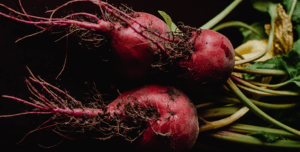
This month’s seed kit features Heirloom Chioggia Beets. To support our environment, seed kits are now available digitally. Scan the QR codes on the seed packets to download planting logs, delicious recipes, fun craft ideas, and coloring pages.
Heirloom Chioggia Beets
Also known as the candy stripe beet, the Chioggia (key-oh-jah) displays distinctive red and white striping when sliced, making a colorful addition to any meal. The leaves are also edible and can be used fresh or cooked!
Planting Instructions
Culture: Beets grow best in cool, sunny weather. Plant seeds in loose soil with full sun exposure. Sow 2 inches apart and 1/2 inch deep in rows 12-18 inches apart. For a continuous supply of beets, sow seeds in 2-week intervals.
Water: Beets need well-irrigated soil to prevent diseases. Keep the soil moist and water beets when the soil becomes dry.
Harvest: Beets should be harvested approximately 60-90 days after planting when they are about 2 inches in diameter for the best flavor. Gently pull the beets out of the soil by the base of the stem. Beet greens are also edible and can be used like spinach.
More About Heirloom Chioggia Beets
Beets originated in the Mediterranean region, where their leaves were valued for medicinal properties as well as a food source by ancient Greeks and Romans. Eating beetroot itself became popular in during the 16th century. The beet was also considered an aphrodisiac and is said to have been favored by Aphrodite.
The colorful Chioggia beet was developed in the Italian village of Chioggia in the early 1800s, first appearing in seed catalogs around 1840. It made the trip to North America in the 1860s where it was introduced at upscale markets.
Nutritionally, beets are high in vitamin C and B6 as well as iron, magnesium, dietary fiber, and other nutrients. The beautiful red color of most beets comes from betalain, which may reduce cancer risk. They are also a natural source of tryptophan and betaine, substances that tend to promote a sense of well-being. So, eat up and be happy!
Beetroot Borani Dip
Serves: 4 Prep time: 10 minutes Cook Time: 40-50 minutes

Ingredients:
- 1 lb. beetroots, washed
- 1 cup of Greek yogurt
- 2 tbsp. lemon juice
- 1 garlic clove
- 2 tbsp. olive oil
- 4 tbsp. feta cheese, crumbled
- 2-3 mint leaves, chopped
- Salt & pepper to taste
Instructions:
- Wash the beetroots thoroughly. Put beetroots in a medium-sized pot, cover with water, and bring to a boil. Reduce heat to a simmer and cook for 40-50 minutes until the beetroots are fork-tender. Drain and leave to cool. Peel off the skin. (Note: Use gloves or a towel when handling cooked beetroots)
- In a food processor, place beetroots, Greek yogurt, lemon juice, garlic clove, extra virgin olive oil, salt, and pepper and process until smooth. Once processed, top with crumbled feta cheese and garnish with chopped mint leaves.
- Serve the dip with crackers, pita, or flatbread. Beetroot Borani dip can be stored in an airtight container in the refrigerator for up to 3 days.
Craft: Beet Ink

You’ll Need:
- 1-2 beets
- Water
- Saucepan
- Strainer
- Knife (with adult supervision when crafting with children)
- Funnel
- Empty jar
Instructions:
- Peel beets and chop them into 1-inch pieces. Put beets in a pan and fill with enough water to cover the beets. Boil water over high heat, then turn to low and simmer for 20 minutes.
- Strain the liquid into your jar and let the beets cool. After the beets have cooled, press the beets through a strainer to get any remaining liquid. Be sure to reuse the beets for something else!
- Stir well and let cool. You can preserve your ink in the freezer or add some rubbing alcohol (this keeps the ink from getting moldy!).


Add a comment to: February 2024: Heirloom Chioggia Beets